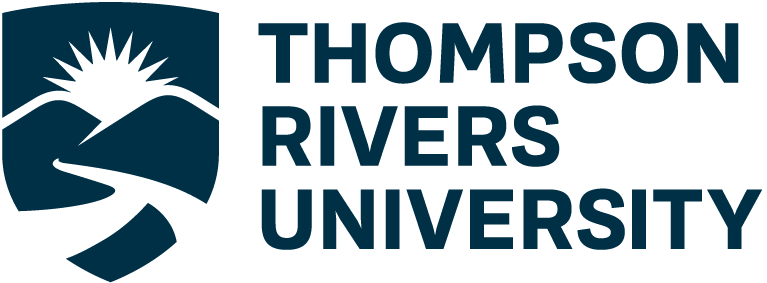Indigenous Inquiry
Have you ever wondered what the difference was between Indigenous methods of learning and Western approaches to learning, and how that affects research? If so you’ve come to the right place! In this section, you will learn the purpose of learning in both worldviews, why this matters in an academic setting, and how you as a student can engage with Indigenous learning.

Purpose of Learning in Indigenous Worldview
The worldview of a group of people affects every aspect of their life, from language and social systems to how and why they choose to learn. This is why when looking at Indigenous inquiry it’s important to understand the different ways that learning is done and how it differs from a Western model of education.
It is important to understand that each Indigenous Nation has its own unique cultural beliefs and education goal, and it would be over simplistic to assume all Indigenous people share the same view of education. There are however, elements of learning that are shared across Indigenous nations.
Through a collaboration with seventy different Indigenous organizations and communities, a report done by the Canadian Council of Learning in 2009 helps outline these shared elements. The CCL’s report says that Indigenous learning:
“is a highly social process that nurtures relationships within the family and throughout the community.
These relationships serve to transmit social values and a sense of identity, and also help to ensure cultural continuity. As a result, the value of individual learning cannot be separated from its contribution to the collective well-being.“
These shared elements state that learning in Indigenous worldviews include being:
- Holistic: Engages the emotional, physical, spiritual and intellectual
- Lifelong: Begins at birth and never stops
- Experiential: Connected to lived experiences and explored through participation
- Rooted in Language and Culture: Language expresses a communities unique values, and sharing knowledge through culture assures cultural continuity
- Spiritually Oriented: Fundamental to the learners spiritual health
- Communal Activity: Parents, family, Elders and community all have a role and responsibility
- Integrates Knowledge Sources: Is adaptive and draws from the best of all available knowledge sources
Please take a moment to explore some example learning models from different Indigenous communities:
First Nations Holistic Lifelong Learning
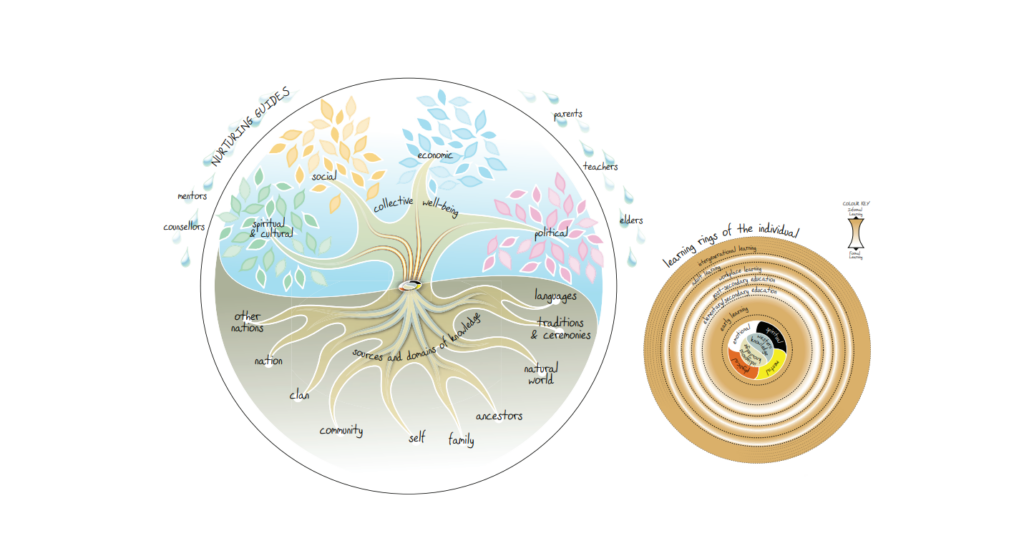
Inuit Holistic Lifelong Learning
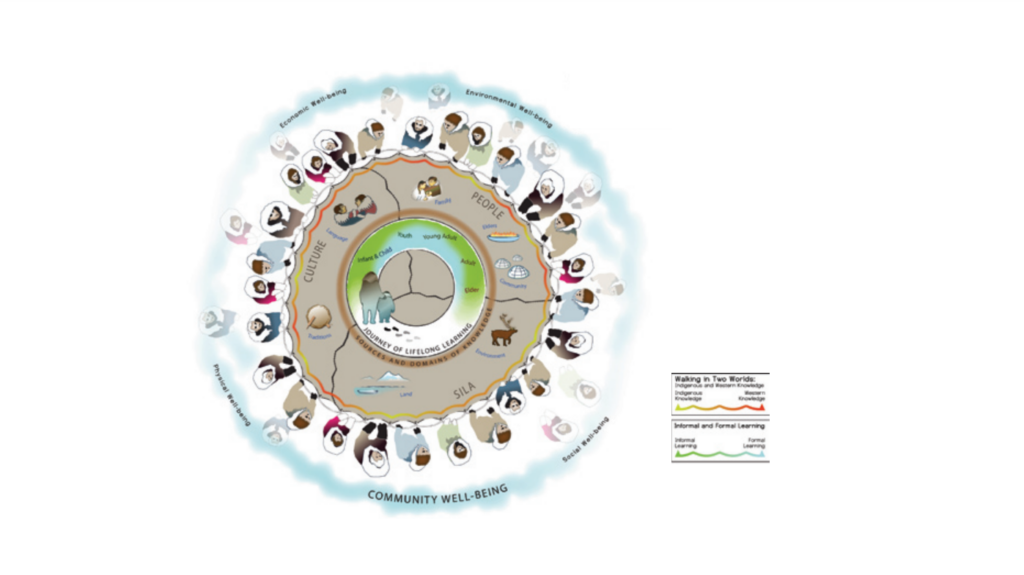
Metis Holistic Lifelong Learning
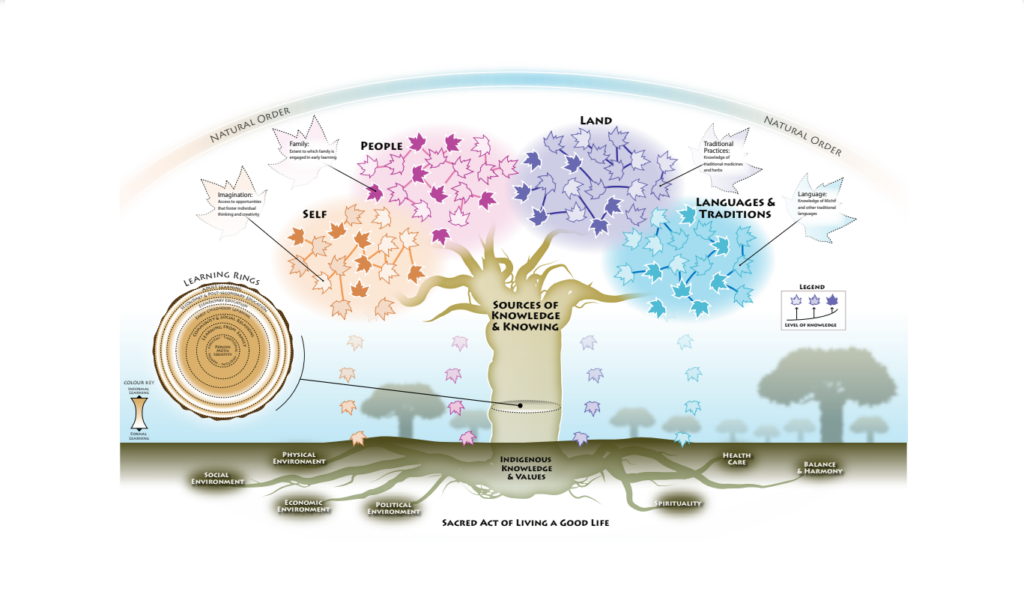
As can be seen in the above learning frameworks, the emphasis within many Indigenous worldviews is in contributing to helping individuals become a full participant in all parts of life- including ceremonies, work life, community and cultivating personal joy and fulfillment.
Purpose of Learning in Eurocentric Worldview
Education within Canada is heavily influenced by European Educational Traditions, which carry with them a specific worldview and purpose to learning. Just like in Indigenous nations, there is not one single model of learning that spans across the entire country, as each province and institution has its own unique educational goals and expected outcomes. There is however a worldview that underpins these outcomes which isn’t often acknowledged as it is seen as “standard”, so in order to better engage with others it is necessary that those of us who are students in Canada are aware of the lens that education is created through.
The United Nations Educational, Scientific and Cultural Organization (2006) outlined four major goals of Education in North America:
- Cultivation of Mind
- Vocational Preparation
- Civic Development
- Individual Development
This approach frames current Canadian education and although educational goals within this structure are constantly changing, experiences that take place without the overview of an institution are not recognized as real learning despite the contribution they make to overall growth and development. Learning in North American education models is identified with formal education that happens within schools, colleges, universities or other recognized learning environments.
Let’s take a look at this video that outlines the types of educational institutions in British Columbia alone:
As this video highlights, within Western worldview, learning must be measured to have commercial value in the economically oriented society. This is a very different and much more formal style of learning than that of Indigenous worldview, which puts emphasis on certificates of completion in order to attain higher education or attain jobs in well paying fields, as well as structured and scheduled learning through government approved organizations.
Why this matters to you as a student in Canada
If you are a student then the education system that you are learning within shapes the type of information and knowledge sources you have access to. As students within Canada, the majority of your learning will happen through a Eurocentric worldview. By understanding the framework that an education model is created through, it can help you as a student to engage with it better and more critically.
As students at Thompson Rivers University, we are on the lands of the Secwépemc people. These lands were never given up, and there were no agreements made where the Secwépemc people signed their approval for their land to be used by others. Recognizing this, it is our responsibility as students to make sure that while we are on these lands we are working to understand the culture, worldview and ways of learning that were traditionally done here for millennia before universities were created.
Although many educational institutions are increasingly working to help integrate Indigenous knowledge, much of the content and research methods you will learn will revolve around the dominant cultures worldview. This does not mean that Indigenous research methods are less legitimate, or that they can not work to uncover and examine a topic. This just means that within Canada, the western worldview is often seen as the only method to learn, and that misconception needs to be fixed.
Now that we have a base understanding as to different purposes of learning, let’s look at how research in an academic setting is done through these worldviews.
First, let’s look at a video explaining the core concepts behind western research methods:
Now, let’s contrast this to how the central elements of Indigenous research are explained:
As you can see from the explanations in the above videos, the fundamental approach to how and why research is done differs based on worldview.
Thankfully, this does not mean that there are not commonalities that can be used by students who wish to incorporate Indigenous methodologies into their current area of interest, or future area of study. An approach to learning that is newly being discussed is called Two-Eyed Seeing.
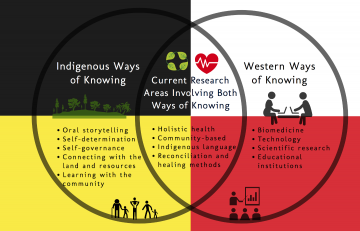
Two-Eyed Seeing is an approach that offers a solution to these separate methods in inquiry, by encouraging people to come together to view the world through and Indigenous lens with one eye, while the other sees through a western lens. This approach was first put into application by Mi’kmaw Elder Albert Marshall of the Eskasoni First Nation, and encourages collaboration of knowledge as well as relationship building, community control and collaboration throughout the data collection process.
References
Canadian Council on Learning. (2009). The state of aboriginal learning in Canada: A holistic approach to measuring success. https://www.afn.ca/uploads/files/education2/state_of_aboriginal_learning_in_canada-final_report,_ccl,_2009.pdf
Jeffery, T., Jones, C., & Kurtz, D. (2021). Two-Eyed seeing: Current approaches, and discussion of medical applications. BC Medical Journal, 63(8), 321–325. https://bcmj.org/articles/two-eyed-seeing-current-approaches-and-discussion-medical-applications#:~:text=ABSTRACT%3A%20Two%2DEyed%20Seeing%20is,sees%20through%20a%20Western%20lens.&text=A%20review%20of%20which%20Indigenous,present%20in%20Western%20medical%20literature.
UNESCO. (2006). World data on education. The United Nations Educational, Scientific and Cultural Organization. http://www.ibe.unesco.org/sites/default/files/Canada.pdf
